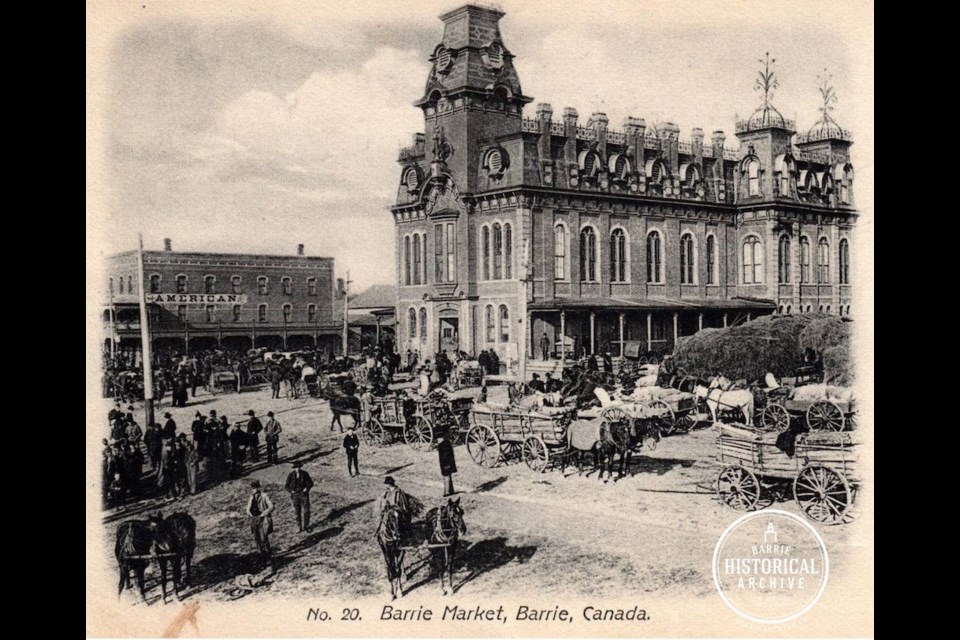I learned a new word today and I had to look up its meaning. Who knew that the plural of beef is beeves? Certainly not I. In any case, Mr. Maundrell was once the man to see about beeves, or any other types of meat or poultry, that you might like to serve for your Christmas dinner.
As was common in those early days of our town, the few merchants wore many hats and were jacks of all trades you might say. George Maundrell was a trained butcher, an auctioneer and a member of Barrie’s small fire department.
He was part owner of Maundrell Brothers “butchers, poulterers, bacon and ham curers, sausage makers” which operated from their shop on Bayfield Street and could also be found at stall number 3 in the market building. From about 1860, the Maundrell name became synonymous with good meats in Barrie.
“The Christmas show of meat on the market this year, although not equal to former years, was excellent! In quality, there is no deficiency to note, but weights are rather lighter. Of those who occupy stalls in the market, we think Mr. Maundrell has, by far, the largest show and best qualities.”
So reported the Northern Advance of Dec. 24, 1864. Buyers were well informed as to where their meat came from at that time. The short article went on to relate that the animals had won prizes at the County Fair, named their breed, who bred them and where, and who had been responsible for their feed.
At that time, Barrie would have been very British in its traditions. The turkey had not yet been established as the must-have meat of choice for the Christmas feast. Beef or goose was still common, depending on what you could afford. Sometimes, rabbit would have had to suffice.
Christmas dinner preparations might begin in autumn with the gathering of chestnuts from local forests. Next, perhaps a month before the big day, Christmas cakes and puddings would be made and stored away until needed.
These sweet treats were baked in a wood fired oven, slowly at low temperatures, or steamed in a cloth, to avoid burning the sugar and fruit ingredients. Next, they were soaked in brandy, or other available alcohol, to preserve and mature the cake or pudding.
Shopping for those ingredients would mean a trip to William Hunter’s Canton T Store, or perhaps to the West End T Store owned by Charles Clark, or Michael Spencer’s fine Toronto Tea Shop. There, customers would find currants and raisins, all sorts of sugars and spices, all manner of beer, wine and spirits, as well as an endless array of teas – congou, oolong, Japan, fine gunpowder and more.
On Christmas morning, the cooks of the household would be up early. A special breakfast of ham and eggs might be had. In any case, normal household or farmyard chores would have to be attended to as they would have on any other day.
Little ones would be very excited. A stocking hung by the fire or on a bedpost might contain an apple, as oranges were an exotic foreign luxury not available in Canada until the late 1800s. The children might also find nuts, candy or perhaps a penny whistle or a little cornhusk doll.
A Christmas tree was not so much a decoration, during Barrie’s formative years, but an event. The average house didn’t have room to set up a full tree nor decorate, it but local churches and schools often held a celebration called a Christmas Tree in the days surrounding Dec. 25. Guests would be treated to drinks and treats, and musical entertainment. Afterwards, small presents that had been hung from the branches of the candlelit tree would be distributed.
Mr. Robert Simpson, brewer and first mayor of the town of Barrie, would have been very pleased to hear that some of the citizens of Barrie had included his special seasonal Christmas Ale in their celebrations. He called it his “sparkling champagne” variety and hoped that glasses of it would be raised all over town during the holiday season.
Each week, the Barrie Historical Archive provides BarrieToday readers with a glimpse of the city’s past. This unique column features photos and stories from years gone by and is sure to appeal to the historian in each of us.



